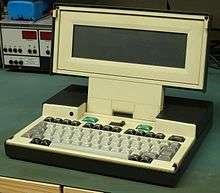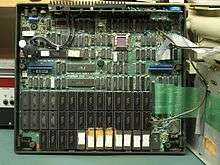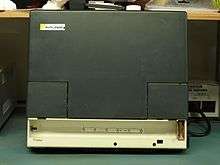Dulmont Magnum
| Also known as | Kookaburra |
|---|---|
| Developer | Dulmison Pty Ltd[2] |
| Manufacturer | Dulmont Electronic Systems Pty Ltd[3] |
| Type | Portable computer |
| Release date |
September 26, 1983 (Australia)[4] 1983 (International) |
| Discontinued | 1986[5] |
| Units shipped | 11000 +[6] |
| Operating system | MS-DOS 2.11[7] |
| CPU | 8-MHz Intel 80186[8][9] |
| Memory |
96KB-384KB RAM, 128KB-384KB ROM |
| Storage | Optionally External Duel 5.25" floppy disk drives, or an External 10 MB hard drive |
| Removable storage | Dual 128K ROM cartridge slots |
| Display |
8 lines, 80 characters LCD screen (1982-1983) 16 lines, 80 characters LCD screen (1984-1985 international release) 25 lines, 80 characters LCD screen (1985-6 final version) Earlier versions were able to be upgraded to the larger displays. |
| Input | 76 key Keyboard |
| Power |
Battery External Mains Power |
| Dimensions | 32 x 27.5 x 5.5cm |
| Weight | 4.8kg |







The Dulmont Magnum [1]was an early laptop computer designed and marketed by Dulmison Pty Ltd[2] in Australia in the early 1980s. The Magnum was also known internationally as the Kookaburra, and was sold from 1982 to 1986. The company found itself undercapitalized as it sought to enter the international market and faced increased competition from other laptops. It was taken over twice, with Dulmont eventually taken over by Time Office Computers (Manufacturing) Pty. Ltd, who marketed the Magnum internationally in 16 and 25 line LCD versions, and also introduced the brandname Kookaburra to emphasize its Australian origins.[10]
The Magnum was one of the first computers to use the 16-bit Intel 80186 processor, and was sold in versions with 96K to 256K of RAM, and inbuilt LCD screens from 8x80 to 25x80 characters. It had a word processor, spreadsheet, telecommunications, file manager, and appointment programs burned into ROM. It also featured dual 128K ROM cartridge slots, which could be used for optional software including BASIC or assembler programming support, as well as serial and parallel modem and printer ports. The 1982 to 1983 prerelease and initial release versions included an 8x80 character LCD screen, whilst the 1984 to 1985 international release[11][12] had a 16x80 display, and the final 1985-6 version had a 25x80 display and for international marketing purposes was given the new name "Kookaburra". Earlier versions were able to be upgraded to the larger displays, and a dual 5.25" floppy drive and memory expansion box provided access to up to 256KB of dynamic RAM. Applications were stored in ROM (A:) and also supported removable modules in expansion slots (B: and C:) that could be custom programmed EPROM or standard word processing and spreadsheet applications. However, the Magnum had no nonvolatile memory, but could suspend and retain memory in RAM, including a RAM Disk (D:). A separate expansion box provided dual 5.25" floppy or 10MB hard disk storage.
The Magnum was arguably the world's first laptop computer, and was to be enabled by a custom power management integrated circuit that was to be developed in the VLSI and Systems Technology Laboratory at the University of New South Wales (UNSW) over 4 months in early 1982 by Graham Hellestrand. However the ~10,000 transistor, 5μ nMOS technology chip never saw the light of day. Terry Crews was the initial Engineering Manager and contracted Barry Wilkinson to design the hardware based on discrete components as he had doubts about the custom chip. The form factor and cosmetic design was developed first and this then dictated the physical dimensions of the hardware. This was in contrast to the usual method of encasing the electronics as the last process and their subsequent bulkier designs.
John Blair led the engineering team.[13][14] Terry Crews became Marketing Manager once the Magnum went into production and the engineering role was taken over by Chris Todter. Terry Crews traveled the world showcasing the product. It attracted substantial interest and some large orders. The Magnum was marketed in Australia from 1983 to early 1986, thus being developed and launched prior to the development of the Grid Compass.
The Magnum was launched publicly at the 10th Australian Computer Conference on same day that Australia won the America's Cup. in September 1983.[4]
The Magnum laptop computer is similar to the Hewlett Packard HP 110 and the Sharp PC-5000. It is the only Australian produced laptop personal computer, but did not survive long on the international market once industry players like HP, Sharp and Sanyo entered the market. One key disadvantage of both the Dulmont Magnum [Kookaburra] and the Grid Compass is that they were developed prior to the IBM PC and were never upgraded to full IBM compatibility, using an early version of MS-DOS (latest version used was 2.11).[7] A second disadvantage of the Magnum was the lack of integral permanent storage other than the ROM/EPROM that was available through the module cartridge slots, or the separate expansion box. In particular, its soon-to-arrive competitors (including the Grid Compass) made use of the new Bubble memory technology to provide non-volatile memory.
In 1985, the Magnum retailed for 2995 AU$ (today $7336.20) for a 96K model, or 4100 AU$ (today $10042.88) for a 256K model..
References
- 1 2 Name:DULMONT MAGNUM / Registered state/no. NSW H6207808 / Type: Business Names /Date Deregistered: 21/08/1986 / Jurisdiction: Office of Fair Trading, New South Wales, Australia, Dulmont Magnum registered business name, Australian Securities & Investments Commission search
- 1 2 Dulmison Pty Ltd - designer of the Dulmon Magnum, Australian Securities & Investments Commission search
- ↑ ..and in 1980-1981 the inaugural R&D Exec. of Dulmont Electronic Systems Pty. Ltd. the designer and maker of arguably the world’s first laptop computer – the Dulmont Magnum., BIOGRAPHY – Dr. Graham Hellestrand (20120723_EST-Bio_v1.0_Hellestrand.pdf)
- 1 2 A truly portable portable from Sharp, From: Stephen Hutcheon of the Sydney Morning Herald ,The Age - Nov 29, 1983, The PC-5000 will cost $2700 and is similar to the recently-released Dulmont Magnum, the Australian-made portable computer which was launched in a blaze of publicity at the 10th Australian Computer Conference in September. ....this new breed, represented by the Magnum and...are truly portable.
- ↑ "COMPUTERS AND TECHNOLOGY Laptops for the artist, or the artisan.". The Canberra Times (ACT : 1926 - 1995). ACT: National Library of Australia. 23 November 1987. p. 12. Retrieved 13 April 2015., There is, however, a sad side to this story. The first lap-top computer was designed and made in Australia about six years ago. It did not advance to the stage where the Toshiba with disc drives. And at first it had only eight lines of screen. But it was state of the art when it first came out as the Dulmont Magnum, and, now selling under the name Kookaburra is still a fine computer for its price. But it failed to get the support it deserved and has been left behind in the weight and-size-for-capacity stakes.
- ↑ Dulmont; Model: DM256 Serial Number:11002, The Archivist Collection Manager
- 1 2 MICROBYTES: Two MS-DOS Portable computers enhanced, Page 10, BYTE Vol 10-08 1985-08 The Amiga, Meanwhile, Australian computer maker Time Office Corp. will enter the U.S. market with the Kookaburra laptop computer. Previously available as the Dulmont Magnum, the Kookaburra includes a 25-line LCD, 256K bytes of RAM, an 80186 processor, a video-output port, MS-DOS 2.11, and several applications programs for less than $2000.
- ↑ Dulmont Magnum, OLD-COMPUTERS.COM Museum
- ↑ "Advertising.". The Canberra Times (ACT : 1926 - 1995). ACT: National Library of Australia. 5 November 1983. p. 8. Retrieved 13 April 2015., Your own personal, portable,affordable, Secretary, DULMONT MAGNUM MACRO-COMPUTER, Revolutionary Australian Design * Full size qwerty keyboard with user definable function keys * 80186 bit CPU processor * Battery powered (up to 20 hours before recharging) * Supporting up to 256 K BYTES of CMOS RAM, 128 K of ROM . 8 line x 80 character liquid crystal display with dot addressable graphics . Two serial and one parallel I/O port . Advanced ROM based operating system and resident basic interpreter . Housing in a very portable package 305 mm x 279 mm x 305 mm -. Weight of less than 4 kg. . Inbuilt software-word processing financial planner and diary. price $2495 (Inc. tax)
- ↑ "Time borrows $1m to buy Dulmont.". The Canberra Times (ACT : 1926 - 1995). ACT: National Library of Australia. 22 October 1984. p. 15. Retrieved 11 April 2015.
- ↑ 2007/49/1 Dulmont Magnum laptop computer and accessories, plastic / metal / glass / electronic components, designed and made by Dulmont Electronic Systems Pty Ltd, Sydney, New South Wales, Australia, 1985, Powerhouse Museum Collection
- ↑ "Dulmont Magnum Portable Computer" (2002/5.1), Dulmont Electronic Systems Propriety Limited, Newcastle Regional Museum.
- ↑ John Blair: Executive Profile & Biography, Businessweek, Mr. Blair worked at Dulmont Ltd., where he managed the engineering team that developed and brought to market the Dulmont Magnum.
- ↑ Prior to 1980, Mr. Blair worked at Dulmont Ltd., an Australian computer company, where he managed the engineering team that developed and brought to market the Dulmont Magnum, the world's first 16-bit laptop computer.
External links
- Dulmont Magnum - the first Aussie micro (evaluation), By John Anderson., CREATIVE COMPUTING VOL. 11, NO. 1 / JANUARY 1985 / PAGE 58
- Dulmont Magnum, Powerhouse Museum collection
- Twentieth anniversary of an Australian first:the Dulmont Magnum laptop, By John Tinney, Old Computers Collection
- Micronews: New portable is a world beater, Page 136, December 1983, Electronics Australia
- Dulmont Magnum - Shows position of ROM cartridges on YouTube